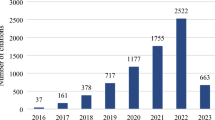Abstract—This paper considers the general and specific problems of multilevel synthesis of models of monitoring objects. These models satisfy the needs of domain experts for model building when solving forecasting and control problems, etc. The general problem can be formulated as a single-objective multi-constrained optimization problem. A set of synthesis efficiency criteria and indicators for assessing synthesized models is proposed. The specific problems of multilevel synthesis are determined in the context of the general problem definition and in terms of the developed set of indicators.

Similar content being viewed by others
REFERENCES
Kotseruba, I. and Tsotsos, J.K., 40 years of cognitive architectures: Core cognitive abilities and practical applications, Artif. Intell. Rev., 2018. https://link.springer. com/article/10.1007/s10462-018-9646-y.
Laird, J.E., The Soar Cognitive Architecture, Cambridge, MA: MIT Press, 2012.
Gore, B.F., Hooey, B.L., Wickens, C.D., and Scott-Nash, S., A computational implementation of a human attention guiding mechanism in MIDAs, International Conference on Digital Human Modeling, San Diego, CA, 2009, vol. 5.
Tecuci, G., et al., An experiment in agent teaching by subject matter experts, Int. J. Hum. Comput. Stud., 2000, vol. 53, no. 4, pp. 583–610.
Langley, P. and Choi, D., Learning recursive control programs from problem solving, J. Mach. Learn. Res., 2006, vol. 7, pp. 493–518.
Bridewell, W. and Bello, P.F., Incremental object perception in an attention-driven cognitive architecture, Proceedings of the 37th Annual Meeting of the Cognition Science Society (CogSci 2015 July 22–25), Pasadena, CA, 2015, pp. 279–284.
Glodek, M., et al., Fusion paradigms in cognitive technical systems for human-computer interaction, Neurocomputing, 2015, vol. 161, pp. 17–37.
Perlovsky, L.I., Cognitive high level information fusion, Inf. Sci., 2007, pp. 2099–2118.
Hawkins, J. and Blakeslee, S., On Intelligence, New York: Times Books, 2004.
Arel, I., Rose, D., and Coop, R., Destin: A scalable deep learning architecture with application to high-dimensional robust pattern recognition, Proceedings of the AAAI Workshop on Biologically Inspired Cognitive A-rchitectures, Washington, D.C., 2009.
O'Reilly, R.C., Braver, T.S., and Cohen, J., A biologically-based computational model of working memory, in Models of Working Memory, Miyake, A. and Shah, P., Eds., New York: Cambridge University Press, 1999, pp. 375–411.
Fleischer, J., Gally, J., Eldeman, G., and Krichmar, J., Retrospective and prospective responses arising in modeled hippocampus during maze navigation by a brain-based device, Proc. Natl. Acad. Sci. Am., 2007, vol. 104.
Modha, S., Introducing a brain-inspired computer TrueNorth’s neurons to revolutionize system architecture. http://www.research.ibm.com/articles/brain-chip.shtml.
Haykin, S., Fatemi, M., Setoodeh, P., and Xue, Y., Cognitive control, Proc. IEEE, 2012, vol. 100, pp. 3156–3169.
Haikonen, P., The role of associative processing in cognitive computing, Cognit. Comput., 2009, vol. 1, pp. 42–49.
Palm, G., Neural associative memories and sparse coding, Neural Networks, 2013, no. 37, pp. 165–171.
Haykin, S., Neural Networks and Learning Machines, New York: Prentice Hall, 2008, 3rd ed.
Osipov, V. and Osipova, M., Space-time signal binding in recurrent neural networks with controlled elements, Neurocomputing, 2018, no. 308, pp. 194–204.
Osipov, V. and Nikiforov, V., Formal aspects of streaming recurrent neural networks, Proceedings 15th International Symposium on Neural Networks Advances in Neural Networks–ISNN 2018; Lect. Notes Comput. Sci., 2018, vol. 10878, pp. 29–36.
Osipov, V., Space-time structure of recurrent neural networks with controlled synapses, Proceedings International Symposium on Neural Networks Advances in Neural Networks–ISNN 2016; Lect. Notes Comput. Sci., 2016, vol. 9719, pp. 177–184.
Osipov, V., Structure and basic functions of cognitive neural network machine, MATEC Web Conf., 2017, vol. 113.
Osipov, V., An associative intelligent machine with three signaling systems, Inf.-Upr. Sist., 2014, no. 5, pp. 12–17.
Osipov, V., Automatic synthesis of multilevel automata models of biological objects, International Conference on Computational Science and Its Applications (ICCSA 2019); Lect. Notes Comput. Sci., 2019, vol. 11620.
Kosters, W.A., Pijls, W., and Popova, V., Complexity analysis of depth first and FP-growth implementations of APRIORI, Machine Learning and Data Mining in Pattern Recognition; Lect. Notes Comput. Sci., 2003, vol. 2734, pp. 284–292.
Foggia, P., Sansone, C., and Vento, M.A., Graph-based representations in pattern recognition, Proceedings of the 3rd IAPR TC-15 Workshop, Ischia, 2001, pp. 188–199.
Cordella, L.P., Evaluating performance of the VF graph matching algorithm, Proc. of the 10th International Conference on Image. Analysis and Processing, 1999, pp. 1172–1177.
Chen’, C. and Li, R., Method of resolutions, in Matematicheskaya logika i avtomaticheskoe dokazatel’stvo teorem (Mathematical Logic and Automatic Proof of Theorems), Moscow: Nauka, 1983, ch. 5, p. 358.
Maslov, S.Yu., The inverse method for establishing derivability for logical calculi, Tr. Mat. Inst.im.V. A. Steklova Akad. Nauk SSSR, 1968, vol. 98.
Donini, F., et al., Reasoning in description logics, in Principles of Knowledge Representation, Stanford, CA: Center for the Study of Language and Information, 1996, pp. 191–236.
Author information
Authors and Affiliations
Corresponding author
Ethics declarations
The authors declare that they have no conflicts of interest.
Additional information
Translated by N. Bogacheva
About this article
Cite this article
Zhukova, N.A. General and Specific Problems of Multilevel Synthesis of Models of Monitoring Objects. Autom. Doc. Math. Linguist. 53, 315–321 (2019). https://doi.org/10.3103/S0005105519060049
Received:
Published:
Issue Date:
DOI: https://doi.org/10.3103/S0005105519060049




